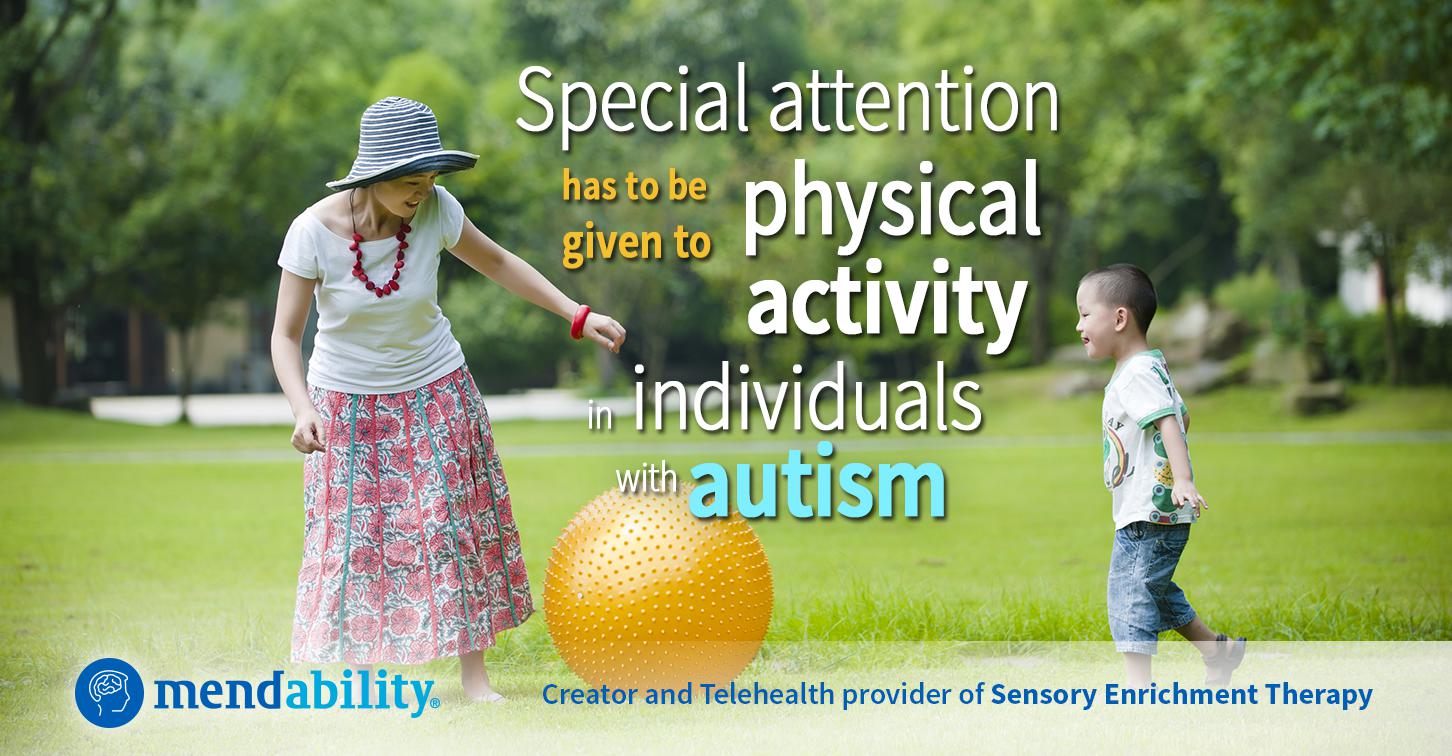Animal and human research show that aerobic exercise helps the brain by improving learning and memory (Kobilo, Yuan, & van Praag, 2011), which has implications for the development of an effective autism therapy, but also in the development of a healthy environment in the home.
Children with autism generally spend less time than their typically developing peers in physical activity (Bandini et al., 2013; Must et al., 2013). Even when they display hyperactive behavior, their physical activity is not necessarily contiguous, sustained, directed, or functional, but is typically maladaptive.
The negative consequences for children with autism who do not participate in physical exercise are both immediate and long-term (National Center for Health Statistics, 2012).
The U.S. Centers for Disease Control and Prevention (CDC) recommend 60 consecutive minutes of daily exercise for children (Arem et al., 2015). Of those 60 minutes, most should be aerobic activity. The American Heart Association recommends that aerobic activity be done at 50-85% of the child’s maximum target heart rate (Physical Activity and Health: A Report of the Surgeon General, 1996).
Although the exercise and activity regimen proposed by the CDC is ideal, it is the unfortunate reality that physical exercise and motor activity participation can be particularly difficult for children with autism because many of them experience motor difficulties (Ming, Xue, Michael, & Wagner, 2007; Pope, Bierman, & Mumma, 1991). In some cases, they avoid physical activity altogether. Activities may be either too noxious (in terms of the sensory requirements for the activity) or too difficult to experience success in coordination-based activities (Leekam, Nieto, Libby, Wing, & Gould, 2007). Therefore, successful participation in physical exercise to promote health and wellness of children with autism may be directly linked to resolving their sensory-motor difficulties.
In our experience with autism therapy, engaging a child with autism in physical activity that is sustained and continuous, with some sort of productive or play-based and directed goal in mind, we usually find a calmer child and one who is ready to be engaged in other social experiences. It seems to fulfill a need that many of these children have.
Participation in Sensory Enrichment Therapy for autism (SET) (Woo & Leon, 2013) has been shown to decrease motor apraxia and increase motor coordination, in addition to many other functional gains (Woo, Donnelly, Robin, & Michael, 2015). This strongly indicates that participation in SET has the potential to help ameliorate sensory and motor dysfunction in children with autism. A secondary benefit may be the increase in healthy participation of physically exertive activities that will contribute to reducing the ever-increasing health crises that face our children today.
One of the tenants of Mendability’s Sensory Enrichment Therapy for autism is participation in physical exercise (Erickson, Leckie, & Weinstein, 2014; Gomez-Pinilla & Hillman, 2013).
Please contact us if you have any questions or post a comment below if would like more information on this article
[av_hr class=’default’ height=’50’ shadow=’no-shadow’ position=’center’ custom_border=’av-border-thin’ custom_width=’50px’ custom_border_color=” custom_margin_top=’30px’ custom_margin_bottom=’30px’ icon_select=’yes’ custom_icon_color=” icon=’ue808′ font=’entypo-fontello’ av_uid=’av-7y2g9′ custom_class=” admin_preview_bg=”]
[av_promobox button=’yes’ label=’Give it a try!’ link=’page,2339′ link_target=” color=’theme-color’ custom_bg=’#444444′ custom_font=’#ffffff’ size=’large’ label_display=” icon_select=’yes’ icon=’ue82b’ font=’entypo-fontello’ box_color=’custom’ box_custom_font=” box_custom_bg=’#def4fc’ box_custom_border=” av_uid=’av-jly8o0ce’ custom_class=” admin_preview_bg=”]
Does your loved one struggle with symptoms of Autism?
Sensory Enrichment Therapy™ helps improve symptoms by boosting brain development in these areas.
[/av_promobox]
[av_hr class=’invisible’ height=’-50′ shadow=’no-shadow’ position=’center’ custom_border=’av-border-thin’ custom_width=’50px’ custom_border_color=” custom_margin_top=’30px’ custom_margin_bottom=’30px’ icon_select=’yes’ custom_icon_color=” icon=’ue808′ font=’entypo-fontello’ av_uid=’av-jly8rlxm’ custom_class=” admin_preview_bg=”]
[av_textblock size=’14’ font_color=” color=” av-medium-font-size=” av-small-font-size=” av-mini-font-size=” av_uid=’av-jly8d2po’ custom_class=” admin_preview_bg=”]
Join 3,000 families in over 60 countries who have used Sensory Enrichment Therapy™ to help boost brain development in their own homes.
[/av_textblock]
[av_toggle_container initial=’0′ mode=’accordion’ sort=” av_uid=’av-4dsec7′]
[av_toggle title=’References’ tags=” av_uid=’av-2hyp3r’]
Arem, H., Moore, S. C., Patel, A., Hartge, P., Berrington de Gonzalez, A., Visvanathan, K., … Matthews, C. E. (2015). Leisure time physical activity and mortality: a detailed pooled analysis of the dose-response relationship. JAMA Internal Medicine, 175(6), 959–967.
Bandini, L. G., Gleason, J., Curtin, C., Lividini, K., Anderson, S. E., Cermak, S. A., … Must, A. (2013). Comparison of physical activity between children with autism spectrum disorders and typically developing children. Autism: The International Journal of Research and Practice, 17(1), 44–54.
Erickson, K. I., Leckie, R. L., & Weinstein, A. M. (2014). Physical activity, fitness, and gray matter volume. Neurobiology of Aging, 35 Suppl 2, S20–8.
Gomez-Pinilla, F., & Hillman, C. (2013). The influence of exercise on cognitive abilities. Comprehensive Physiology, 3(1), 403–428.
Kobilo, T., Yuan, C., & van Praag, H. (2011). Endurance factors improve hippocampal neurogenesis and spatial memory in mice. Learning & Memory , 18(2), 103–107.
Leekam, S. R., Nieto, C., Libby, S. J., Wing, L., & Gould, J. (2007). Describing the sensory abnormalities of children and adults with autism. Journal of Autism and Developmental Disorders, 37(5), 894–910.
Ming, X., Xue, M., Michael, B., & Wagner, G. C. (2007). Prevalence of motor impairment in autism spectrum disorders. Brain and Development, 29(9), 565–570.
Must, A., Phillips, S. M., Curtin, C., Anderson, S. E., Maslin, M., Lividini, K., & Bandini, L. G. (2013). Comparison of sedentary behaviors between children with autism spectrum disorders and typically developing children. Autism: The International Journal of Research and Practice, 18(4), 376–384.
National Center for Health Statistics. (2012). Health, United States, 2011: With Special Feature on Socioeconomic Status and Health. National Center for Health Statistics.
Physical Activity and Health: A Report of the Surgeon General. (1996). Government Printing Office.
Pope, A. W., Bierman, K. L., & Mumma, G. H. (1991). Aggression, hyperactivity, and inattention-immaturity: Behavior dimensions associated with peer rejection in elementary school boys. Developmental Psychology, 27(4), 663–671.
Woo, C. C., Donnelly, J. H., Robin, S.-E., & Michael, L. (2015). Environmental Enrichment as a Therapy for Autism: A Clinical Trial Replication and Extension. Behavioral Neuroscience. http://doi.org/10.1037/bne0000068
Woo, C. C., & Leon, M. (2013). Environmental enrichment as an effective treatment for autism: a randomized controlled trial. Behavioral Neuroscience, 127(4), 487–497.
[/av_toggle]
[/av_toggle_container]
[/av_textblock]

